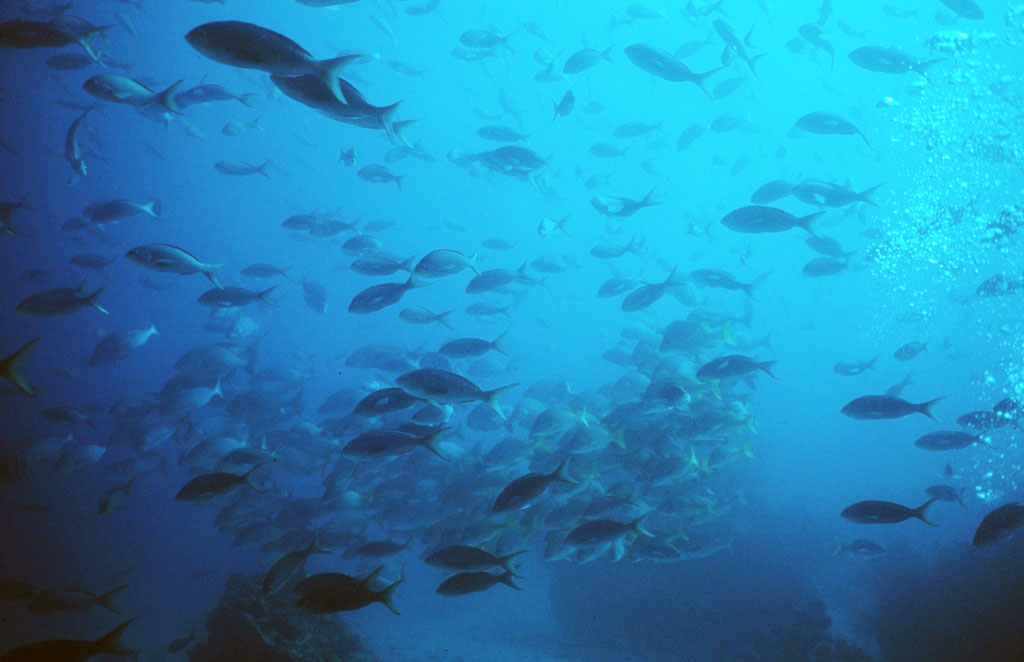
Diving amongst a school of fish in the Galápagos Islands. Photo © Derek Keats, licensed Creative Commons Attribution.
With such an astonishing array of marine life, it’s no surprise that the Galápagos ranks among the world’s best dive destinations. The New York Zoological Society’s Oceanographic Expedition sent divers to the islands for the first time in 1925, and they’ve been returning ever since. In 1998 protection of the land sites was extended to a marine zone 74 kilometers offshore, and there are now some 60 dive sites around the archipelago, many of them closed to nondivers.If you’re dreaming of getting your PADI certification and heading straight here, however, be advised that diving in the Galápagos is not for beginners. Local dive schools offer PADI training, but it is overpriced and far from the best place to learn. You are better off not only learning elsewhere but getting a few dives under your belt first. Currents are strong, and visibility is often poor, ranging 10-25 meters (half that of the Caribbean). Many dives are in unsheltered water, meaning that holding onto coral is not only permitted but is essential. It is not ideal for the health of the coral, but it is certainly important for your health. There have been diving accidents here—some people get so excited by what they are seeing that they lose track of time and distance. Luckily, there is a decompression chamber in Puerto Ayora.
For those with sufficient experience, the diving is world-class. Schools of fish stretch out for what seems like eternity, and you’re almost guaranteed close encounters with a variety of sharks—small white-tipped reef sharks, larger Galápagos sharks, the dramatically shaped hammerheads, and off the more remote western islands, enormous whale sharks. When you add to this extended periods following manta rays, marine iguanas, and the surprisingly fast penguins, the diving in the Red Sea or the Caribbean will pale in comparison.
Recent changes in the law mean that every boat in the Galápagos must be either a nondiving cruise boat or a dedicated dive boat, so divers are now forced to choose between live-aboard charters, which are very expensive, or a land-based tour with day trips to dive sites. The latter option is becoming more popular because it’s far cheaper, but note that you will be restricted to sites within easy reach of Santa Cruz and San Cristóbal. Popular sites include Academy Bay, Santa Fé, Gordon Rocks, Daphne Minor, Mosquera, Seymour Norte, and Cousins.
However, the most spectacular diving can only be experienced on a live-aboard around Darwin and Wolf. These islands are a full day’s sail north of the main island group. Schools of hundreds of hammerheads can be seen off Wolf, and gigantic whale sharks cruise slowly by June-November. Bottlenose dolphins are common at Darwin’s Arch.
The best diving is during the hot season (Dec.-May), with 20-25°C water temperatures making a three-millimeter wetsuit adequate. Temperatures drop to 15°C in the cold season, when a six-millimeter wetsuit with hood, booties, and gloves becomes necessary. It’s best to bring all your own equipment, as renting it locally is expensive and can cause problems because many itineraries go straight to the boat. Bring a mask, dive alert whistle, and sausage or scuba tuba. Boats supply tanks, air, and weights.
Because most visitors depart by plane, you must leave a day free at the end of your dive trip to avoid possible decompression problems (most dive tours spend the last day on Santa Cruz).
Excerpted from the First Edition of Moon Galápagos Islands.